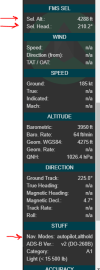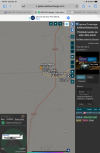Dang, I’m sorry to hear that.
There will be a lot to unpack with this one.
For a timestamp, the last ADS-B hit was on 12/14 at 1817:47Z
Here was the last METAR at SJT:
KSJT 141751Z 10006KT 10SM OVC011 10/08 A3031 RMK AO2 SLP263 60004 T01000083 10100 20072 58013
No significant changes at the next routine observation, just a slightly better ceiling
The TAF for that time period was:
KSJT 141737Z 1418/1518 11010KT P6SM OVC020
The next change wasn’t forecast until 0200. SJT was issuing new TAFs every hour or two for a while, indicating lower ceilings.
Winds aloft at 3000’ were 150 at 21
Winds aloft at 6000’ were 179 at 33
Airport elevation is 1919
N188PC was on a vector to DBASE, which is the center IAF at the T-style RNAV platform (has a HILPT). The profile altitude is 4100’ minimum until crossing DBASE, then 4000’ to TIMPP.
According to ADS-B data, 8PC was approaching DBASE from the northeast on a 210° heading, with autopilot and alt hold on at 4300 selected, ground speed 190.
(communication times approximate and comms paraphrased, ADS-B times from the website)
At 1816:30, 8PC was 3NM SE of DBASE, still 120°, still 4300, autopilot and alt hold. ATC gave them a left turn to 270, 8PC asked if that was supposed to be right, quipped that left is the long way around” ATC confirmed right 270
In the turn to 270, groundspeed increased to 230kts, no other changes
At 1817:14, ATC gave the PTAC: 8 miles from TIMPP, turn right 030(!) maintain 4300 until established on the final approach course, cleared RNAV 36.
I want to interject here that to this point, in the last 17 minutes of the recording twice I heard ATC tell 8PC 4000 instead of 4300, and the first time, several minutes prior, 8PC also read back 4000 (thus heard what I heard). In playing it back, the controller veritably mumbled “three hundred” both times, kind of fast talk and tailed off. It was hard to discern. Anyway, 8PC read back the approach clearance correctly.
Per ADS-B, at 1817:30, the heading selector was set to 300°(!) altitude 4300 in a slight descent and groundspeed 241
Just about the same time, 8PC transmitted “we overshot it” ATC responded, “that’s why I gave you 030.”
At about 1817:38, the autopilot mode was changed to LNAV and alt hold. The aircraft was on a 320° track and about 450fpm descent, which increased to 1000fpm a few seconds later. FMS SEL still showed about 4300’ selected on the alt hold as they descended through about 3800’
5 seconds later, the vertical speed went over 4000, increasing to 5000 down. No apparent change from the FMS.
About that same time, 8PC said “we got a problem”
That was the last transmission from 8PC
The last ADS-B hit was four seconds later,
At 1817:47. 259kts GS, 2800’ -5056 fpm.
No apparent change in the autopilot. The ground in that area is about 2100’ MSL.
I’m still chewing on this, but those are the approximate data so far.
Sad, RIP all.
Edit to remove reference to the airmet and CWA which were a couple dozen miles to the NW.




